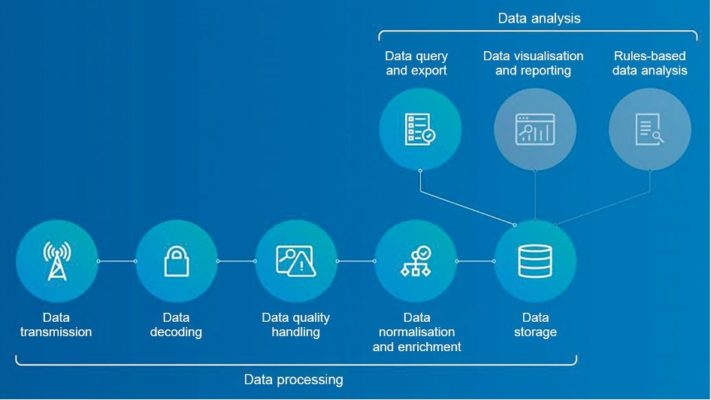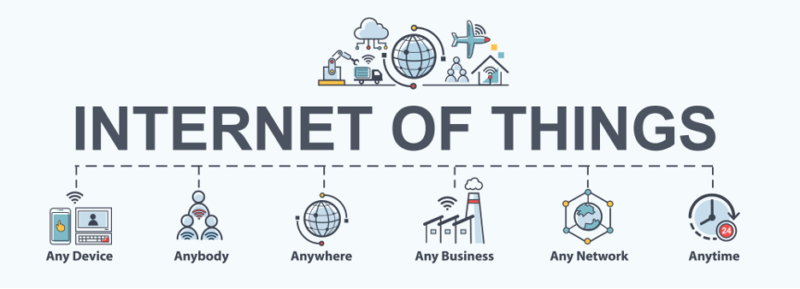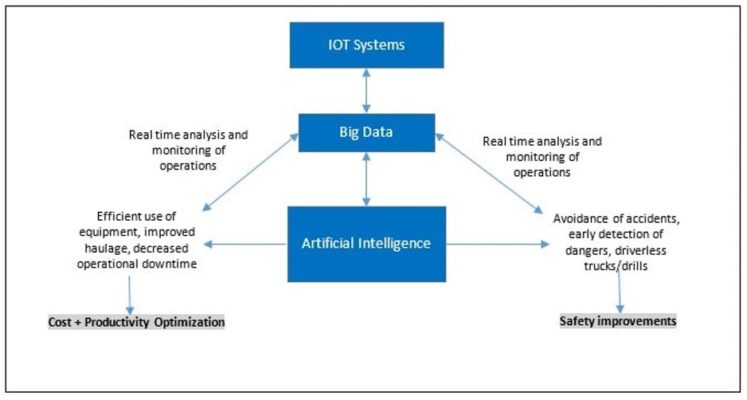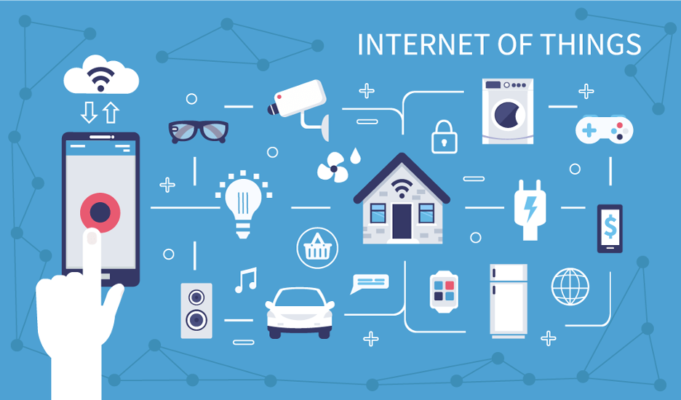Definition of Internet of Things (IoT )
The Internet of Things stands for IoT. Things refer to the items we use in our daily lives (e.g., domestic appliances and electronics). These items, termed the Internet of Things, are accessible or connected through the Internet. A network of physical items incorporated in the software, electrical devices and sensor systems that allow these things to gather and share data may be characterized as the Internet of Things.
The IoT objective is to increase the connectivity of the Internet from ordinary devices such as computers, mobile telephones, and electrical gadgets. Due to various technology convergence, real-time analytics, machine education, computer computer science, commodity sensors, and embedded systems, things have evolved. The Internet is supplemented by traditional areas of embedded systems, wireless sensor networks, control systems, automation (including building automation and home automation), and others. IoT technology is the most synonymous consumer technology with goods that support one or more common ecosystems under the idea of “smart home,” incorporating gadgets and appliances (for example lighting systems, thermostats, security systems, cameras, etc.). In medical systems, the IoT can also be employed.
The growing risk of the IoT is a series of severe issues, in particular in the field of privacy and safety.

Fig.1: Description image for IoT (Source: https://www.tutorialandexample.com/iot-tutorial/)
2. Sensors Data Management
Data management is the process of collecting and improving the whole accessible data. Different gadgets send enormous quantities and types of information from different applications. The management of all this IoT data requires creating and implementing architectures, rules, practices, and methods that satisfy the whole demands of the data life cycle.
Things are controlled by intelligent gadgets for task automation so that our time is saved. Smart objects can gather, transmit and comprehend information, and a tool to aggregate information and make conclusions, trends and patterns will be necessary.
 Fig.2: Steps in IoT data management ( Source: https://iot.electronicsforu.com/content/tech-trends/data-management-systems-iot-devices/)
Fig.2: Steps in IoT data management ( Source: https://iot.electronicsforu.com/content/tech-trends/data-management-systems-iot-devices/)
Thousands of sensors interact with and beyond individuals, homes, cities, farms, factories, workplaces, automobiles. The Internet of Things (IoT) transforms our lives from household appliances to cars. Devices can tell us what to do when to do it, and where to go today. In controlling operations and prediction of problems and calamities, industrial IoT apps support us. The IoT platforms enable the specification and management of data settings properly.
3. IoT Mining and Analytics
-
-
What is IoT Mining
-
The Internet of things (IoT) is the expansion to physical devices and ordinary objects of an Internet link. Embedded with electronics, Internet connectivity and other technology; these devices communicate, interact with, and can be monitored and controlled remotely over the Internet. IoT is utilized in the mining sector to optimize costs and efficiency, improve safeguards and improve their artificial intelligence requirements.
 Fig.3.1: Below are some of the instances of IoT in the mining industry(Source: https://www.infosysbpm.com/blogs/sourcing-procurement/iot-in-mining.html)
Fig.3.1: Below are some of the instances of IoT in the mining industry(Source: https://www.infosysbpm.com/blogs/sourcing-procurement/iot-in-mining.html)
-
IoT in the Mining Industry
Given the various incentives it offers, many major mining firms plan and evaluate approaches in mining to start their digital journeys and digitize in order to manage daily mining operations. For instance:
- Optimization of costs and enhanced productivity through the deployment of sensors and systems for the control and performance of mining equipment. These huge amounts of data – ‘big data – are used by mining firms to find more economical methods to operate and also minimize operational inactivity overall.
- Ensure the safety of people and equipment with real-time IoT control of ventilation and toxicity levels in deep mines. It makes evacuations or safety exercises faster and more efficient
- Moving from preventive to predictive maintenance
- Enhanced and quick decision-making The mining sector has a high unpredictability in emergencies nearly every hour. In instances where many factors simultaneously work to change ordinary activities into algorithms, IoT helps to compensate for conditions and to take the appropriate judgments.
4. What is IoT Analytics
The IoT analysis (Internet of Things) is a data analysis tool to evaluate a wide variety of IoT device data. IoT analysis evaluates and generates valuable information about huge volumes of data.
In conjunction it Industrial IoT analytics is frequently addressed (IIoT). Data are gathered from a broad variety of sensors on production facilities, weather stations, smart metering systems, delivery vehicles and other machinery types. For the management of retail and healthcare data centers, IoT analytics may be utilized.
IoT data is similar to large data in many respects. The main difference not only is the amount of data but also the variety of sources from which it is derived. All of this information has to be transformed into a single, understandable data stream. Given various types of information sources, data integration becomes very challenging, and it might be hard to design and apply IoT analytics.

Fig.3.2: Description image for IoT analytics ( Source: https://www.robomq.io/blog/iot-analytics-what-is-that/)
5. Types of IoT Data Analytics
- IoT Data Description Analysis
Concentrate on how the IoT device, machine, product, and asset status are being monitored. Determine whether everything is on schedule and alert if anything extraordinary occurs. In general, descriptive analytics are used to present current and historical sensor data, key performance indicators (KPIs) as well as statistics and warnings.
- IoT data diagnostic analysis
Analyze IoT data to discover and enhance a service, product, or process for fundamental problems.
Diagnostic capacity is typically an addition to Dashboards that allows users to uniquely perceive correlations and patterns in data, analyze data and compare them. Many organizations, rather than data scientists, make diagnoses on the data by using domain experts with understanding about a particular process, equipment, device or product.
- IoT data predictive analysis
Assess the probability, based on previous evidence, of something happening in a certain time range. It is designed to take proactive measures, decrease risks or isolate possibilities before an unwanted consequence happens.
Usually used by learning machines educated with historical data and stored in the cloud so that end-user applications are available.
- IoT data descriptive analysis
Suggest measures based on prediction or diagnostic findings or offer visibility of a prediction or a diagnosis explanation. There are suggestions for optimizing or fixing something
6. IoT Data Analytics Applications
To increase crop output, plan and maintain agricultural operations, farmers use data obtained through IoT devices. The Climate Corporation uses IoT devices that detect soil quality and moisture, to enable farmers to determine how crops are rotated and when irrigated. Farms also use IoT equipment to get data from agricultural tractors and use IoT drones for analytical aerial pictures.
- IoT Data Analytics in Food Services
Restaurants and bars use IoT to check their stocks and to develop more effective methods of management. A firm named I-TAPR2 technologies employs a wireless smart tap, which monitors beer flow and helps food services managers identify the goods that most sell, when fresh stocks are ordered, which drinks are marketable, and which are supposed to stop being carried.
- IoT Data Analytics in Logistics Management
We have already shown, through our example, how IoT data analytics may affect the management of logistics. UPS says on its website that it can save over $400 million yearly through data analysis. Most of it is on the transport side, but there are still more possibilities to use the IoT on the warehouse side of the logistics. In order to optimize the layout, minimize labor costs, monitor inventory and order across the supply chain, and automate inventory management in order to eliminate mistakes, the warehouse can employ sensors and robotics.
7. SOURCE:
https://iot.electronicsforu.com/content/tech-trends/data-management-systems-iot-devices/
https://www.infosysbpm.com/blogs/sourcing-procurement/iot-in-mining.html
https://www.tibco.com/reference-center/what-is-iot-analytics
https://www.totalphase.com/blog/2019/10/what-is-iot-data-analytics-internet-of-things/
https://www.tutorialandexample.com/iot-tutorial/
https://en.wikipedia.org/wiki/Internet_of_things
